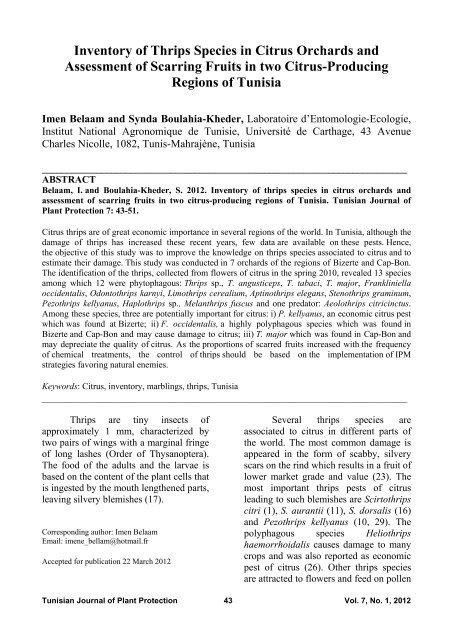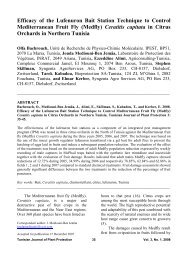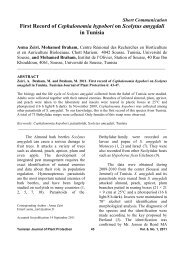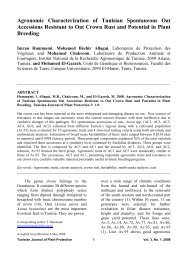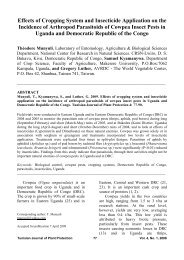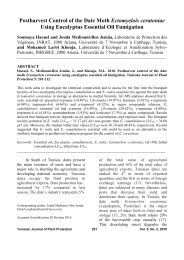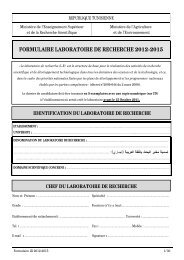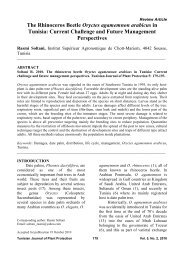Tunisia - Iresa
Tunisia - Iresa
Tunisia - Iresa
Create successful ePaper yourself
Turn your PDF publications into a flip-book with our unique Google optimized e-Paper software.
Inventory of Thrips Species in Citrus Orchards and<br />
Assessment of Scarring Fruits in two Citrus-Producing<br />
Regions of <strong>Tunisia</strong><br />
Imen Belaam and Synda Boulahia-Kheder, Laboratoire d’Entomologie-Ecologie,<br />
Institut National Agronomique de Tunisie, Université de Carthage, 43 Avenue<br />
Charles Nicolle, 1082, Tunis-Mahrajène, <strong>Tunisia</strong><br />
__________________________________________________________________________<br />
ABSTRACT<br />
Belaam, I. and Boulahia-Kheder, S. 2012. Inventory of thrips species in citrus orchards and<br />
assessment of scarring fruits in two citrus-producing regions of <strong>Tunisia</strong>. <strong>Tunisia</strong>n Journal of<br />
Plant Protection 7: 43-51.<br />
Citrus thrips are of great economic importance in several regions of the world. In <strong>Tunisia</strong>, although the<br />
damage of thrips has increased these recent years, few data are available on these pests. Hence,<br />
the objective of this study was to improve the knowledge on thrips species associated to citrus and to<br />
estimate their damage. This study was conducted in 7 orchards of the regions of Bizerte and Cap-Bon.<br />
The identification of the thrips, collected from flowers of citrus in the spring 2010, revealed 13 species<br />
among which 12 were phytophagous: Thrips sp., T. angusticeps, T. tabaci, T. major, Frankliniella<br />
occidentalis, Odontothrips karnyi, Limothrips cerealium, Aptinothrips elegans, Stenothrips graminum,<br />
Pezothrips kellyanus, Haplothrips sp., Melanthrips fuscus and one predator: Aeolothrips citricinctus.<br />
Among these species, three are potentially important for citrus: i) P. kellyanus, an economic citrus pest<br />
which was found at Bizerte; ii) F. occidentalis, a highly polyphagous species which was found in<br />
Bizerte and Cap-Bon and may cause damage to citrus; iii) T. major which was found in Cap-Bon and<br />
may depreciate the quality of citrus. As the proportions of scarred fruits increased with the frequency<br />
of chemical treatments, the control of thrips should be based on the implementation of IPM<br />
strategies favoring natural enemies.<br />
Keywords: Citrus, inventory, marblings, thrips, <strong>Tunisia</strong><br />
__________________________________________________________________________<br />
Thrips are tiny insects of<br />
approximately 1 mm, characterized by<br />
two pairs of wings with a marginal fringe<br />
of long lashes (Order of Thysanoptera).<br />
The food of the adults and the larvae is<br />
based on the content of the plant cells that<br />
is ingested by the mouth lengthened parts,<br />
leaving silvery blemishes (17).<br />
Corresponding author: Imen Belaam<br />
Email: imene_bellam@hotmail.fr<br />
Accepted for publication 22 March 2012<br />
Several thrips species are<br />
associated to citrus in different parts of<br />
the world. The most common damage is<br />
appeared in the form of scabby, silvery<br />
scars on the rind which results in a fruit of<br />
lower market grade and value (23). The<br />
most important thrips pests of citrus<br />
leading to such blemishes are Scirtothrips<br />
citri (1), S. aurantii (11), S. dorsalis (16)<br />
and Pezothrips kellyanus (10, 29). The<br />
polyphagous species Heliothrips<br />
haemorrhoidalis causes damage to many<br />
crops and was also reported as economic<br />
pest of citrus (26). Other thrips species<br />
are attracted to flowers and feed on pollen<br />
<strong>Tunisia</strong>n Journal of Plant Protection 43 Vol. 7, No. 1, 2012
ut they are not generally considered as<br />
citrus pests, and there are few reports of<br />
any of these species damaging this crop.<br />
For example, in Southern Italy and in<br />
Cyprus, Frankliniella occidentalis<br />
dominate the thrips fauna of citrus but is<br />
not considered as a pest of citrus (14).<br />
In <strong>Tunisia</strong>, damages attributed to<br />
thrips on several varieties of citrus fruits<br />
have been reported during these last<br />
years. A recent work made in 2008 on<br />
citrus, in the region of Mraïssa (Cap-Bon)<br />
showed the presence of 8 species among<br />
which P. kellyanus which is economically<br />
very harmful on citrus fruits (21).<br />
However, until now, there is not any<br />
measure to control thrips citrus which<br />
were considered as secondary pests. In<br />
contrast, this species causes in Australia<br />
important damages on young and mature<br />
fruits by scurfing (or halo) marking and<br />
rind bleaching that depreciate fruit quality<br />
(4).<br />
P. kellyanus population can be<br />
reduced by insecticide applications (4,<br />
28). Various insecticides were evaluated<br />
in field trials against larval stages I and II.<br />
Among these, the organophosphate<br />
chlorpyrifos, the carbamate methomyl,<br />
and the neonicotinoid acetamiprid were<br />
the most effective (28). However,<br />
repeated chemical treatments can lead to<br />
development of resistance, as it has been<br />
reported to chlorpyrifos in South<br />
Australia, resulting in control failures (3,<br />
24).<br />
In <strong>Tunisia</strong>, works on thrips in<br />
citrus orchards are rare because until the<br />
last years, these pests were considered as<br />
secondary and probably because of the<br />
difficulties to study these minute and<br />
hidden insects. Thus, the objective of this<br />
work is a better knowledge of the species<br />
living in citrus orchards and their status.<br />
Moreover, it aims to determine the most<br />
widespread species in two regions of the<br />
North of <strong>Tunisia</strong>: Cap-Bon and Bizerte,<br />
and especially to confirm the presence of<br />
P. kellyanus. We also tried to estimate the<br />
damages caused by thrips on several<br />
varieties of citrus fruits, in relation with<br />
the frequency of the phytosanitary<br />
treatments.<br />
MATERIALS AND METHODS<br />
Trial sites. Twenty three orchards,<br />
10 of the region of Cap-Bon (localities of<br />
Mraïssa, Menzel Bouzelfa, Goba and<br />
Beni Khalled) and 13 of the region of<br />
Bizerte (localities of Alia, Azib, Ras-<br />
Jebel and Sounine), have been surveyed<br />
from December 2009 to March 2010 to<br />
try to estimate the thrips damage.<br />
Estimation of thrips damage. In<br />
these orchards, with a surface nearly of 1<br />
ha, several varieties have been<br />
considered: Grape-fruit, Orange<br />
(Thomson, Maltaise, Valencia-late,<br />
Double-fine, Navel and Meski),<br />
Clementine (Hermandina, MA3, Kassar)<br />
and Lemon. On all of them, we estimated<br />
at the harvest the proportion of scarred<br />
fruits caused either by thrips or by other<br />
factors; because we noticed that for an<br />
unexperienced person it was difficult to<br />
separate accurately the scarred fruits by<br />
the thrips and those damaged by others<br />
factors. The total number of fruits<br />
examined was about 450 for all the<br />
varieties encountered in the orchard.<br />
Then, we calculated the infestation rate<br />
that is: (Number of scarred fruits × 100) /<br />
Total number of examined fruits. Besides,<br />
an investigation was made about the<br />
treatments applied in the orchards to<br />
relate them to the recorded damages.<br />
Thrips species in citrus<br />
orchards. Thrips were collected in the<br />
orchards where the infestation rate was<br />
the highest in both regions, because we<br />
supposed that the thrips species and<br />
densities would be highest in these<br />
<strong>Tunisia</strong>n Journal of Plant Protection 44 Vol. 7, No. 1, 2012
orchards. Thus, 7 orchards from the 23<br />
prospected were chosen: 3 orchards in the<br />
region of Cap-Bon and 4 orchards in the<br />
region of Bizerte.<br />
The thrips were collected from 25<br />
March to 29 April 2010 during bloom<br />
stages, fall of petals and at the beginning<br />
of fruit formation. The sample was<br />
obtained by beating tray of the branches<br />
on a white cloth of 50 cm × 50 cm<br />
tightened on a wooden frame. Forty<br />
branches per variety of citrus were beaten<br />
and for each tree, a branch<br />
orientation was hitten. The thrips fallen<br />
on the cloth were got back by a little<br />
aspirator, and then maintained in alcohol<br />
10% until their identification. Then, in the<br />
laboratory, the adults were separated from<br />
larvae under binocular magnifying glass,<br />
and some microscopic preparations were<br />
made of them. The protocols used were<br />
those Strassen (5) and Mound and Tree<br />
(18). Finally, insects were mounted in<br />
balm of Canada.<br />
The identification of genus and<br />
species was made after observation of<br />
several morphological criteria under<br />
microscope. The main studied<br />
morphological characters were the wing<br />
nervation, the projection of the head, the<br />
number of antennal segments, the<br />
sensorias on the antennal segments 3 and<br />
4, the pronotum chetotaxy, the<br />
mesothoracic fork and the shape of the<br />
abdominal segment 10. The identification<br />
was based on the keys of Palmer et al.<br />
(22) and Moritz (19). The species were<br />
confirmed by Mrs V. Balmes from the<br />
National Laboratory of Plant Protection<br />
(LNPV) of Montpellier.<br />
RESULTS<br />
Thrips species and distribution<br />
in citrus orchards.<br />
Thrips species in citrus orchards.<br />
Thrips collected in citrus orchards were<br />
identified as 13 species, 12 among them<br />
belong to the sub-order of Terebrantia<br />
namely Thrips sp., T. angusticeps, T.<br />
tabaci, T. major, Frankliniella<br />
occidentalis, Odontothrips karnyi,<br />
Limothrips cerealium, Aptinothrips<br />
elegans, Stenothrips graminum,<br />
Pezothrips kellyanus, Melanthrips fuscus<br />
and Aeolothrips citricinctus. One was<br />
identified as Haplothrips sp. which is a<br />
tubuliferan thrips.<br />
Twelve species of the thrips<br />
collected are phytophagous and only one,<br />
A. citricinctus, is predator.<br />
Distribution of thrips in the citrus<br />
orchards. The Table 1 shows that 6 of the<br />
13 thrips species collected (Thrips sp., O.<br />
karnyi, L. cerealium, F. occidentalis, M.<br />
fuscus and A. elegans) have been reported<br />
in both biotopes while the 7 others have<br />
been found only in Cap-Bon (A.<br />
citricinctus, T. major, T. tabaci, S.<br />
graminum, Haplothrips sp. and T.<br />
angusticeps) or only in Bizerte (P.<br />
kellyanus).<br />
The genus Thrips occurred in the<br />
whole of the orchards of both biotopes on<br />
the varieties of oranges Valentia Late,<br />
Maltaise, Double fine, Thomson, Meski,<br />
and Lemon. The species O. karnyi was<br />
recorded in 4 orchards of 7 on the<br />
varieties of oranges Thomson, Valentia<br />
Late and Meski and on the clementine<br />
MA3, and Kassar. The species F.<br />
occidentalis, which has been already<br />
observed in <strong>Tunisia</strong> on several crops (15),<br />
was found in 3 orchards of 7 on several<br />
varieties of citrus fruits: oranges<br />
Thomson, Maltaise and Valentia Late and<br />
the variety of clementine MA3. P.<br />
kellyanus was found in the region of Azib<br />
in Bizerte (Table 1).<br />
<strong>Tunisia</strong>n Journal of Plant Protection 45 Vol. 7, No. 1, 2012
Table 1. Thrips species collected in 7 citrus orchards of <strong>Tunisia</strong> (Bizerte and Cap-Bon) from 25 March<br />
to 29 April 2010<br />
Family Species Locality Region Citrus variety<br />
Mraissa chatt<br />
Goba<br />
Mraissa<br />
Cap-Bon<br />
Valencia late<br />
Maltaise<br />
Double fine<br />
Thripidae<br />
Thrips sp.<br />
Azib 1<br />
Meski<br />
Azib 2<br />
Alia<br />
Bizerte<br />
Thomson<br />
Maltaise<br />
Sounine<br />
Lemon<br />
Mraissa chatt Cap-Bon Valencia late<br />
Azib 1<br />
Meski<br />
Thripidae<br />
Odontothrips karnyi<br />
Azib 2<br />
Sounine<br />
Bizerte<br />
MA3<br />
Kassar<br />
Thomson<br />
Thripidae<br />
Limothrips cerealium<br />
Mraissa chatt<br />
Valencia late<br />
Cap-Bon<br />
Mraissa<br />
Kassar<br />
Azib1 Bizerte Meski<br />
Thripidae<br />
Frankliniella occidentalis<br />
Mraissa chatt<br />
Goba<br />
Cap-Bon<br />
Valencia late<br />
Thomson<br />
Maltaise<br />
Thripidae<br />
Aeolothripidae<br />
Aptinothrips elegans<br />
Melanthrips fuscus<br />
Alia Bizerte MA3<br />
Mraissa chatt Cap-Bon Valencia late<br />
Azib 1 Bizerte Meski<br />
Mraissa chatt Cap-Bon Valencia late<br />
Azib 2 Bizerte MA3<br />
Aeolothripidae<br />
Aeolothrips citricinctus<br />
Mraissa chatt<br />
Goba<br />
Cap-Bon<br />
Valencia late<br />
Maltaise<br />
Thripidae Thrips major Mraissa chatt Cap-Bon Valencia late<br />
Thripidae Thrips tabaci Mraissa chatt Cap-Bon Valencia late<br />
Thripidae Stenothrips graminum Mraissa chatt Cap-Bon Valencia late<br />
Phlaeothripidae Haplothrips sp. Mraissa chatt Cap-Bon Valencia late<br />
Thripidae Thrips angusticeps Mraissa chatt Cap-Bon Valencia late<br />
Thripidae Pezothrips kellyanus Azib Bizerte Thomson<br />
<strong>Tunisia</strong>n Journal of Plant Protection 46 Vol. 7, No. 1, 2012
Thrips damages in citrus<br />
orchards. The thrips damage is<br />
characterized by silvery discolorations on<br />
mature fruits. We noticed that these<br />
discolorations can have several<br />
appearances: rings at the base of the<br />
peduncles of fruits with or without<br />
marblings or marbling surfaces more or<br />
less spread on the mature fruits (Figure<br />
1). If the first symptoms can be attributed<br />
undoubtedly to thrips and very probably<br />
to P. kellyanus infestation because they<br />
are specific to this species, for the second<br />
it is much harder to determine the causal<br />
pest. Indeed, such symptoms can be<br />
caused by biotic (thrips or other insects)<br />
or abiotic factors (wind, branch rubbing,<br />
etc). All these symptoms have been<br />
encountered varying from 47 to 72% and<br />
39 to 86% of fruits respectively in Bizerte<br />
and Cap-Bon orchards but we are not able<br />
at this stage to precise the proportion of<br />
scarred fruits caused by thrips.<br />
Interestingly, we remarked that the<br />
percentage of damaged fruits increases<br />
with the frequency of chemical treatments<br />
(Table 2).<br />
a<br />
b<br />
c<br />
d<br />
Fig. 1. Different appearances of scarred fruits observed in the regions of Cap-Bon and Bizerte<br />
(<strong>Tunisia</strong>). a and b: ring on the base of the peduncle and on the base of fruit very probably caused by<br />
thrips on mature oranges of the varieties Valencia late and Thomson, respectively. c and d:<br />
Marblings on mature oranges of the varieties Thomson and Grapefruit, respectively.<br />
<strong>Tunisia</strong>n Journal of Plant Protection 47 Vol. 7, No. 1, 2012
Table 2. Frequency of the chemical treatments<br />
in citrus orchards (Cap-Bon and Bizerte<br />
regions, <strong>Tunisia</strong>) made from 25 March to 29<br />
April 2010<br />
Chemical treatments Scarred fruits<br />
(number / year)<br />
4 - 7<br />
9 - 14<br />
16 - 21<br />
25 – 30<br />
(%)<br />
46.37<br />
57.26<br />
60.26<br />
65.52<br />
DISCUSSION<br />
This work on citrus thrips in<br />
<strong>Tunisia</strong> has lead to two results: a<br />
preliminary composition of the species<br />
living on citrus trees and a global<br />
estimation of the proportion of fruits<br />
damaged either by thrips or other factors<br />
causing nearly the same symptoms.<br />
The inventory of thrips in 7 citrus<br />
orchards, in which the proportion of<br />
scarred fruits were high, showed a varied<br />
fauna composed by 10 genus and 13<br />
species, 12 of them are plant feedings and<br />
one is predator. As compared to findings<br />
from other countries, the biodiversity of<br />
thrips species in citrus orchards is lower.<br />
Indeed, often more than 40 thrips species<br />
have been identified in association with<br />
citrus in the world (13). In Florida, for<br />
example, the inventory of thrips species<br />
in 7 citrus orchards showed 36 species<br />
among which 7 are predatory, 21 are<br />
phytophagous and 8 are mycophagous<br />
(8). Our results expressing a relatively<br />
low biodiversity can be explained by the<br />
high number of chemical treatments<br />
applied in the sampled orchards (in<br />
average 16 treatments/year). The forty<br />
species found in Florida were from<br />
orchards with reduced to no pesticide<br />
spray programs. Moreover, the short<br />
period of the sampling (from 25 March to<br />
29 April 2010) could explain the low<br />
number of collected thrips species. For<br />
instance, in Florida, the 36 species<br />
identified were found after a sampling<br />
monthly for thrips over 13 months in 7<br />
citrus orchards (8). Furthermore, in our<br />
work, thrips were collected mainly from<br />
citrus trees, while the cover ground plants<br />
on which can live most citrus thrips<br />
species, have not been regularly sampled.<br />
Among the thrips species<br />
identified, P. kellyanus, the most<br />
economically important species, was<br />
found to be the less frequent as it was<br />
noted only in the region of Bizerte in one<br />
orchard on three in the locality<br />
of Azib on Meski oranges.<br />
The other few widespread species<br />
that have been reported only in Cap-Bon<br />
and in one or two on four orchards are: A.<br />
citricinctus, T. major, T. tabaci, T.<br />
angusticeps and S. graminum. All these<br />
species were found only on Valencia late<br />
oranges.<br />
The onion thrips, T. tabaci have<br />
a broad host range including citrus genus<br />
but is not reported as a typical pest<br />
of citrus (26). The species T. major is<br />
also polyphagous but has been<br />
reported only once as a damaging pest<br />
of citrus in North Africa (6). The species<br />
T. angusticeps, rather associated with<br />
cereals and leguminous crops, has been<br />
reported also on citrus in Turkey and<br />
Spain but its status as pest of citrus has<br />
not been confirmed yet (26). The thrips<br />
S. graminum which is normally<br />
associated with grasses (12) was also<br />
found on citrus but is not reported as a<br />
pest of this crop (20). The thrips<br />
Aeolothrips which colonizes herbaceous<br />
plants, shrubs and trees in countries<br />
of Europe and North Africa appears to be<br />
a facultative predator (12).<br />
The most widespread species<br />
found in both regions of Cap-Bon and<br />
<strong>Tunisia</strong>n Journal of Plant Protection 48 Vol. 7, No. 1, 2012
Bizerte, are Thrips sp., O. karnyi, L.<br />
cerealium, F. occidentalis, M. fuscus and<br />
A. elegans. Only Thrips sp. was found in<br />
7 orchards and on 6 citrus varieties. Thus,<br />
this species seems to be common both at<br />
the spatial scale and at the varietal scale.<br />
Among the largely widespread<br />
species, F. occidentalis calls for a<br />
particular<br />
interest since it<br />
can cause damage to citrus in Japan and<br />
Korea (9, 27).<br />
Although reported in several citrus<br />
orchards, O. karnyi is rather related<br />
to beans than to citrus. L. cerealium found<br />
in 3 of 7 citrus orchards in the two<br />
regions is also very polyphagous and is<br />
particularly associated to grasses and do<br />
not cause damage to citrus (12). It also<br />
has been found on citrus in Spain in 48 of<br />
100 citrus orchards in Valencia (20).<br />
A recent study conducted in<br />
Turkey on the abundance of thrips in<br />
weeds of protected crops and citrus<br />
orchards revealed similar findings<br />
as those obtained from our study. This<br />
result reinforces the idea that many of<br />
the identified<br />
thrips species<br />
are polyphagous and common in all the<br />
Mediterranean area, in many cultivated<br />
and spontaneous plants (2).<br />
To summarize, the survey<br />
confirmed the presence of P. kellyanus in<br />
Bizerte (locality of Azib). This species,<br />
which is the only one among those<br />
recorded that is known as citrus pest<br />
feeding on very young fruits, was<br />
reported for the first time in <strong>Tunisia</strong> in<br />
Cap-Bon in 2008 (25). Thus, P. kellyanus<br />
is now present in two major citrus regions<br />
in the North and North-East of the<br />
country. F. occidentalis and T. major<br />
should also be monitored to precise their<br />
real status against citrus fruits. The other<br />
genera i.e. Thrips, Haplothrips,<br />
Aptinothrips, Melanthrips, Odontothrips<br />
and Limothrips, listed from citrus flowers<br />
are not regarded as citrus pests although<br />
they can dominate the thrips fauna<br />
associated to this crop (26).<br />
Others data are needed in the<br />
future to determine the dominant thrips<br />
species and their respective status towards<br />
citrus fruits in <strong>Tunisia</strong>. This study<br />
estimate the total of scarred fruits to 40-<br />
86%, but does not precise the part due to<br />
thrips and in particular to P. kellyanus, a<br />
major pest of citrus in other countries.<br />
Moreover, the cultural practices should<br />
also consider mainly the chemical<br />
treatments frequency as they are<br />
associated to thrips multiplication or<br />
resurgence (30).<br />
ACKNOWLEDGMENTS<br />
The authors would like to thank Mr. Fraj<br />
Jrad for his help and Mr. Mouldi Fezzani for his<br />
availability. Thanks to the farmers visited<br />
especially: Mr. Mohamed Chaaben ex. Director of<br />
SMVDA-Mraïssa, Mr. Elyess Ben Romdhan and<br />
Mr. Tarek Abbess in the region of Cap-Bon and Mr.<br />
Nejib Ouerteni Director of Flor’alia-Alia, Mr.<br />
Mohamed Ben Rached, Mr. Ali Ayed, and Mr. Arbi<br />
Kaboubi in the region of Bizerte for their assistance<br />
during the realization of this study. Thanks to Dr.<br />
Cristina Navarro, Campus from UPV of Spain, for<br />
introducing me to thrips study and to Dr. Valerie<br />
Balmes from LNPV of Montpellier, for confirming<br />
the identification of thrips.<br />
__________________________________________________________________________<br />
RESUME<br />
Belaam I. et Boulahia-Kheder S. 2012. Inventaire des espèces de thrips en vergers d’agrumes et<br />
estimation des fruits dépréciés dans deux régions agrumicoles de la Tunisie. <strong>Tunisia</strong>n Journal of<br />
Plant Protection 7: 43-51.<br />
Les thrips des agrumes présentent un intérêt économique important dans plusieurs régions du<br />
monde. En Tunisie, bien que les dégâts imputables aux thrips aient augmenté ces dernières années, peu<br />
de données sont disponibles sur ces ravageurs. Ainsi, l’objectif de cette étude est la connaissance des<br />
<strong>Tunisia</strong>n Journal of Plant Protection 49 Vol. 7, No. 1, 2012
espèces de thrips sur agrumes ainsi que l’estimation de leurs dégâts. Cette étude a été réalisée dans les<br />
régions de Bizerte et Cap-Bon dans 7 vergers. L'identification des thrips, collectés à partir des fleurs<br />
d’agrumes au printemps de 2010, a révélé 13 espèces dont 12 sont phytophages: Thrips sp., T.<br />
angusticeps, T. tabaci, T. major, Frankliniella occidentalis, Odontothrips karnyi, Limothrips<br />
cerealium, Aptinothrips elegans, Stenothrips graminum, Pezothrips kellyanus, Haplothrips sp.,<br />
Melanthrips fuscus et une espèce prédatrice: Aeolothrips citricinctus. Parmi ces espèces, trois sont<br />
potentiellement importantes pour les agrumes. Il s’agit de: i) P. kellyanus ravageur d’importance<br />
économique des agrumes est déjà établi, qui a été trouvée à Bizerte; ii) F. occidentalis espèce très<br />
polyphage qui a été trouvée à Bizerte et au Cap-Bon et peut causer des dégâts sur les agrumes; iii) T.<br />
major qui a été trouvée au Cap-Bon et peut déprécier la qualité des agrumes. Vu que les proportions de<br />
fruits dépréciés augmentent avec la fréquence des traitements chimiques, la lutte contre les thrips<br />
devrait se baser sur la mise en place de stratégies de lutte intégrée favorisant les ennemis naturels.<br />
Mots clés: Agrumes, inventaire, marbrures, thrips, Tunisie<br />
__________________________________________________________________________<br />
ملخص<br />
بلعم، ايمان وسندة بولحية-خذر. 2012. دراسة أنواع حشرات التربس<br />
التشوّه على الثمار في منطقتين<br />
في بساتين/بيارات القوارص/الحمضيات وتقييم<br />
لإنتاج القوارص في تونس.<br />
<strong>Tunisia</strong>n Journal of Plant Protection 7: 43-51.<br />
يعد تربس القوارص/الحمضيات من الحشرات ذات الأهمية الاقتصادية في عدة مناطق منتجة للقوارص في العالم.<br />
وفي تونس، رغم زيادة الأضرار الناتجة عن التربس في السنوات الأخيرة، تبقى البيانات المتوفرة عن هذه الآفة قليلة.<br />
تهدف هذه الدراسة إلى تحسين المعرفة حول أنواع التربس المرافقة للقوارص وتقدير أضرارها. تمت دراسة أنواع<br />
التربس المرتبطة بأزهار القوارص في سبعة بساتين/بيارات من منطقتي بنزرت والوطن القبلي. أظهرت النتائج وجود<br />
و<br />
و<br />
نوعا من التربس خلال ربيع منها نوعاً نباتي التغذية هي<br />
13<br />
T. tabaci T. angusticeps Thrips sp. :<br />
12 2010<br />
و Frankliniella occidentalis و Odontothrips karnyi و Limothrips cerealium<br />
و T. major Haplothrips sp. Pezothrips kellyanus و Stenothrips graminum<br />
و Aptinothrips elegans .Aeolothrips citricinctus<br />
.F، occidentalis الذي تم<br />
والثالث T.major<br />
و<br />
و<br />
من بين هؤلاء الأنواع، يوجد ثلاثة ذات أهمية على القوارص: الأول<br />
وواحد مفترس هو<br />
.Pالذي kellyanus يعتبر من الآفات الاقتصادية على القوارص ووجد في بنزرت والثاني<br />
الذي عثر عليه في<br />
العثور عليه في بنزرت والوطن القبلي ويمكن أن يسبب أضرارا على القوارص،<br />
الوطن القبلي ويمكن أن يخفض من جودة القوارص. وباعتبار أن نسب الثّمار المتضررة ترتفع مع ارتفاع المعاملات<br />
الكيميائية، يتعين أن تستند مكافحة التربس على تنفيذ استراتيجيات مكافحة متكاملة للآفات تعزز وجود الأعداء الطبيعية.<br />
آلمات مفتاحية: تربس، تمرمر، تونس، جرد، قوارص/حمضيات<br />
__________________________________________________________________________<br />
LITERATURE CITED<br />
1. Anonymous. 1984. Integrated Pest Management<br />
for Citrus. University of California Integrated<br />
pest management program, California, 144 pp.<br />
2. Atakan, E. and Uygur, S. 2005. Winter and<br />
spring abundance of Frankliniella spp. and<br />
Thrips tabaci Lindeman (Thysanoptera:<br />
Thripidae) on weed host plants in Turkey. J.<br />
Appl. Entomol. 129: 17-26.<br />
3. Baker, G., Jackman, D., Keller, M., MacGregor,<br />
A., and Purvis, S. 2002. Development of an<br />
integrated pest management system for thrips in<br />
Citrus. Horticulture Australia, Sydney, 124 pp.<br />
4. Baker, G.J., Keller, M.A., Crisp, P., Purvis, S.,<br />
Jackman, D., and Barbour, D.B. 2004.The<br />
Biological control of Kelly’s citrus thrips in<br />
Australian citrus orchards. Poster at the XXII<br />
International Congress of Entomology, August<br />
15-21, 2004, Brisbane, Australia.<br />
5. Boudabbous, S. 1992. Initiation à<br />
l’identification et aux techniques de montage<br />
des thrips de quarantaine. Stage en Entomologie<br />
encadré par Dr. Richard Zur Strassen. Institut<br />
Senckenberg de Francfort, Allemagne.<br />
6. Bournier, A. 1963. Un nouveau déprédateur des<br />
agrumes en Afrique du Nord Thrips major<br />
Uzel. Rev. Pathol. Vég. Entomol. Agr. France<br />
42: 120-125.<br />
7. Childers, C.C. and Stransly, P.A. 2005. Thrips<br />
(Thysanoptera: Thripidae) pests of Florida<br />
grapefruit: Biology, seasonal and relative<br />
<strong>Tunisia</strong>n Journal of Plant Protection 50 Vol. 7, No. 1, 2012
abundance, fruit damage and monitoring.<br />
University of Florida. Proc. Fla. State Hort.<br />
Soc. 118: 54-61.<br />
8. Childers, C.C. and Nakahara, S. 2006.<br />
Thysanoptera (thrips) within citrus orchards in<br />
Florida: Species distribution, relative and<br />
seasonal abundance within trees, and species on<br />
vines and ground cover plants. J. Insect Sc. 6:<br />
3-7.<br />
9. Kim, D.-H., Kwon, H.-M., and Kim, K.-S.<br />
2000. Current status of the occurrence of the<br />
insect pests in the citrus orchards in Cheju<br />
Island. Korean J. Appl. Entomol. 39: 267-274.<br />
10. Froud, K.J., Stevens, P.S., and Steven, D. 2001.<br />
Survey of alternative host plants for Kelly’s<br />
Citrus thrips (Pezothrips kellyanus) in Citrus<br />
growing regions. NZ Plant Protection 54: 15-<br />
20.<br />
11. Grov’e, T., Giliomee, J.H., and Pringle, K.L.<br />
2000. Seasonal abundance of different stages of<br />
the Citrus thrips, Scirtothrips aurantii, on two<br />
mango cultivars in South Africa.<br />
Phytoparasitica 28: 1-11.<br />
12. LLorens climent, J.M. and Lacasa Plasencia, A.<br />
1996. Thrips y su control biológico (I). Pages<br />
93-114. In: Trips de cereales y gramíneas<br />
pratenses. PISA Ediciones, Alicante, Spain.<br />
13. Longo, S. 1986. Thrips on Citrus-groves. Pages<br />
121-125. In: Integrated pest control in Citrusgroves.<br />
R. Cavalloro, and E. Dimartino, eds.<br />
A.A. Balkema. Rotterdam, Netherlands.<br />
14. Marullo, R. 2001. Impact of an introduced pest<br />
thrips on the indigenous natural history and<br />
agricultural systems. Pages 285-288. In<br />
Proceedings of the 7 th international Symposium<br />
on Thysanoptera in Thrips and Tospoviruses. R.<br />
Marullo and L.A. Mound, Eds. July 2-7, 2001,<br />
University of Reggio Calabria, Italy.<br />
15. Masmoudi, S. 2003. Comment améliorer la lutte<br />
contre les thrips californien? Phytiatrie. Tounes<br />
el Khadra. Juin-Juillet-Août 2003: 15-17.<br />
16. Masui, S. 2007. Synchronism of immigration of<br />
adult yellow tea thrips, Scirtothrips dorsalis<br />
Hood (Thysanoptera: Thripidae) to Citrus<br />
orchards with reference to their occurrence on<br />
surrounding host plants. Appl. Entomol. Zool.<br />
42: 517-523.<br />
17. Mound, L.A. 2005. Thysanoptera: Diversity and<br />
Interactions. Annu. Rev. Entomol. 50: 247-269.<br />
18. Mound, L.A. and Tree, D.J. 2009. Identification<br />
and host-plant associations of Australian<br />
Sericothripinae (Thysanoptera, Thripidae).<br />
Zootaxa 1983: 1-22.<br />
19. Moritz, G. 1994. Pictorial key to the<br />
economically important species of<br />
Thysanoptera in central Europe. EPPO Bull. 24:<br />
181-208.<br />
20. Navarro, C.G., Pastor, M.P., Ferragut, F., and<br />
Marí, F.G. 2008. Thrips (Thysanoptera)<br />
asociados a parcelas de Citricos en la<br />
comunidad Valenciana: abundancia, evolución<br />
estacional y distribución espacial. Bol. San.<br />
Veg. Plagas 34: 53-64.<br />
21. Navarro, C.G., Aguilar, A., and Marí, F.G.<br />
2009. Reconocimiento de inmaduros y adultos<br />
de Pezothrips Kellyanus (Tysanoptera:<br />
Thripidae) y caracterización de sus daños en<br />
cítricos. Phytoma-España 214: 1-3.<br />
22. Palmer, A., Mound, L.A., and duHeaume,<br />
G.J. 1989. CIE Guides to insects of importance<br />
to Man, 2 Thysanoptera. Bull. Entomol. Res.<br />
80: 489-489.<br />
23. Parker, B. and Skinner, M. 1997. Integrated<br />
pest management (IPM) in tree crops. Pages<br />
615-638 in: Thrips as crop pests. T. Lewis, Ed.<br />
CABI Publishing, Wallingford, UK.<br />
24. Purvis, S. 2002. Are KCT developing resistance<br />
to chlorpyrifos? Talking thrips in citrus Talking<br />
thrips in citrus. SARDI 2:1.<br />
.<br />
25. Trabelsi, I. and Boulahia-Kheder, S. 2009. Sur<br />
la présence en Tunisie du thrips des agrumes<br />
Pezothrips kellyanus (Thysanoptera: Thripidae).<br />
Ann. INRAT 82: 181-186.<br />
26. Teksam, I. and Tunç, I. 2009. An analysis of<br />
Thysanoptera associated with citrus flowers in<br />
Antalya, Turkey: Composition, distribution,<br />
abundance and pest status of species. Appl.<br />
Entomol. Zool. 44: 455-464.<br />
27. Tsuchiya, M. and Furuhashi, K. 1993. Outbreak<br />
of Western flower thrips (Frankliniella<br />
occidentalis Peragnde), its damage to Satsuma<br />
mandarin growing in venyl greenhouses, and its<br />
distribution in Shizuoka Prefecture, Japan. Proc.<br />
Kanto-Tosan Plant Prot. Soc. 40: 265-268.<br />
28. Vassiliou, V.A. 2007. Chemical control of<br />
Pezothrips kellyanus (Tysanoptera: Thripidae)<br />
in Citrus plantations in Cyprus. Crop Prot. 26:<br />
1579-1584.<br />
29. Webster, K.W., Cooper, P., and Mound, L.A.<br />
2006. Studies on kelly’s Citrus thrips,<br />
Pezothrips kellyanus (Bagnall) (Thysanoptera:<br />
Thripidae): sex attractants, host associations<br />
and country of origin. Aust. J. Entomol. 45: 67-<br />
74.<br />
30. Zalom, F.G. and Flint, M.L. 1990. Integrated<br />
pest management in California. California<br />
Agriculture 44: 4-6.<br />
-------------------------<br />
<strong>Tunisia</strong>n Journal of Plant Protection 51 Vol. 7, No. 1, 2012
<strong>Tunisia</strong>n Journal of Plant Protection 52 Vol. 7, No. 1, 2012


